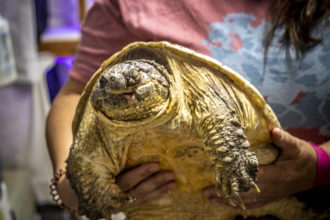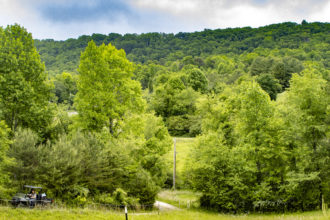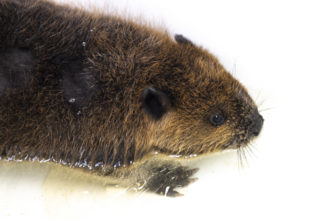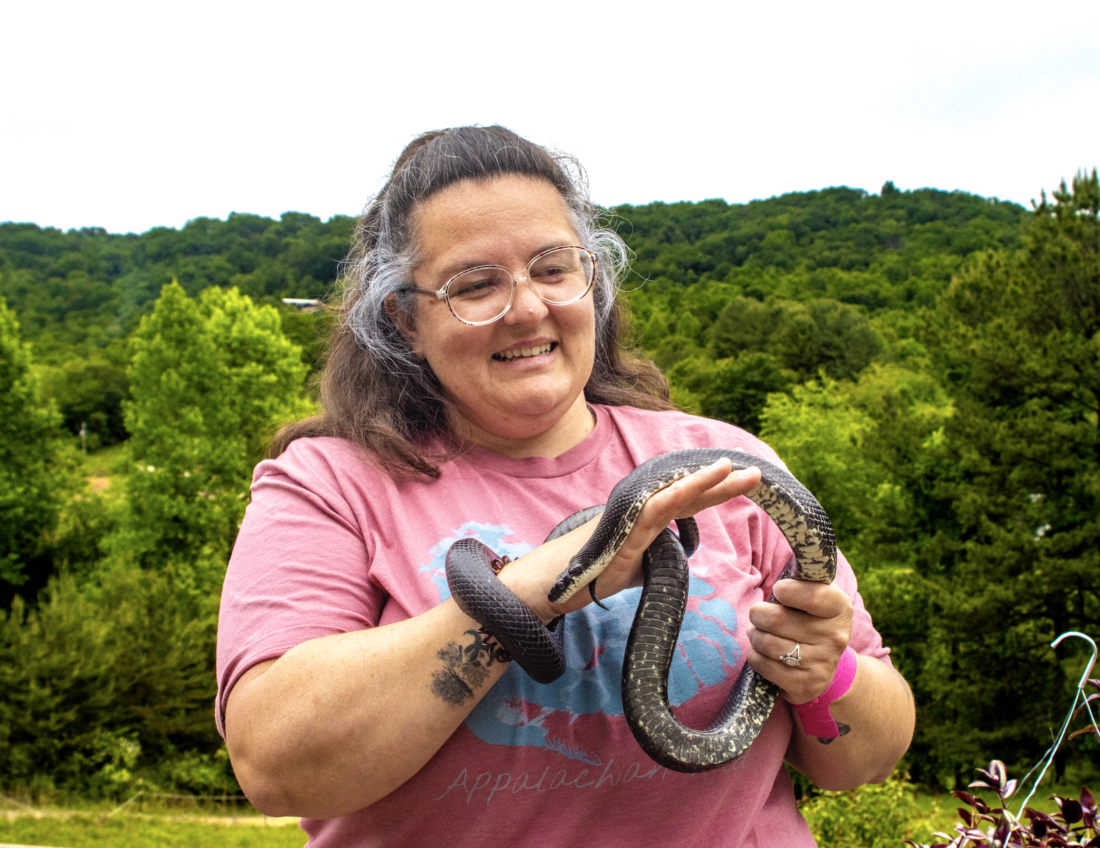I told anyone who would listen that I was going to meet the black bear cub from that viral video.
You know the one. In April, several people in Asheville were filmed pulling two teeny, tiny black bear cubs out of a tree and taking selfies with them. A woman drops one and it tries to flee, scrambling for a nearby fence. The selfie-taker chases the cub, presumably to try and pick it up again. (The video, taken by people watching in disgust, then cuts out.)
After the manhandling, one of the cubs, a female, was found wet and alone in a retention pond, exhibiting signs of stress. A biologist from the N.C. Wildlife Resources Commission also had concerns that the cub’s foot was injured because of the way she was holding her paw. The biologist brought the cub to Appalachian Wildlife Refuge in Candler, which is caring for her until she’s old enough to be safely released in the wild. (Her sibling appears to have retreated to the woods and reunited with the mama bear.)
A press release from AWR explained that bear cubs are among its most expensive patients. Unfortunately, there is no end to the harm humans cause bears, the nonprofit says, from collisions to dog encounters to a rapidly shrinking habitat. I contacted the group about writing an article about its work, particularly the costs associated with bear rehabilitation.
AWR co-founder, certified wildlife rescuer and all-around wonder woman Savannah Trantham welcomed me and Caleb Johnson, the Xpress photographer, photographer to visit. (AWR is not open to the general public.) The morning of, I was so excited — because, you see, I was going to meet a bear cub! — I accidentally left my house a half-hour early for the interview.
You can probably tell where this story is headed.
Upon arriving at the refuge, Trantham graciously explained to Caleb and me that we wouldn’t be seeing any bear cubs. (The refuge has another orphaned cub in its care.)
“There’s no interaction with them,” Trantham explained. Two staff from the refuge are assigned to care for cubs, and “unless we have no other choice, or something happens, those are the only two people those cubs ever see and work with.”
Even those two caretakers — beartakers, if you will — don’t play with or handle them. They clean up the cubs’ space and provide food. “And then we’re exiting,” Trantham said. “So they are not seeing us more than absolutely necessary. … It’s to ensure that they stay wild. All animals have the ability to habituate and become too accustomed to people — whether that’s because they think they’re going to get fed, or they just lose the fear of people or pets, etc.”
Trantham continued, “It’s really important that when we are raising cubs to go back into the wild that they are successful wild bears — meaning that they get put into the wild and they stay in the depths of the wild.”
Of course that makes sense. Of course I couldn’t meet the bear cub. Of course I felt silly. And disappointed. Who wouldn’t?
But as Trantham showed us around the refuge — the turtle yard, the “nursery” of wild babies, an injured baby beaver sitting in shallow water in a sink because he doesn’t yet know how to swim — I had a realization.
As much as I’ve heaped scorn on the bear cub selfie-takers, I understood their excitement. (Though let me be clear that I’d never pull a bear cub out of a tree, or chase it.) It’s normal to feel delight around animals, wild animals especially. At the risk of sounding saccharine, Mother Nature is awe-inspiring. There’s an intoxicating feeling when you might have the opportunity to see or touch an animal when most of humanity never will.

However, as Trantham illustrated while guiding us around the thrumming wildlife refuge, the best way to honor that awe is to allow wild animals to stay wild. Experts like the AWR team exist to provide specialized help — to incubate eggs, to apportion food to hungry birds every 20-30 minutes, to perform surgeries on wild animals with gunshot wounds, such as Crash, a snapping turtle who was found with bullet fragments in her shell and face. But unless these critters are incapable of surviving in the wild due to their injuries, their access to humans is limited. The wild is their home.
And humans like me need to remain their feared predator — even though, in my heart, I’d like to be their friend.
‘Nabbed and grabbed’
Regarding the black bear cub from the viral selfie video, and the people who snatched him from the tree, Trantham was professional and diplomatic. (It should be noted, NCWRC did not fine the individuals.)
“It’s superunfortunate for the bear cubs because it’s invasive for them,” she said. “It’s invasive for any wildlife to be nabbed and grabbed out of the wild. Even to bears, as big as they are, we are a predator. Especially for babies, [a human] is a giant predator.” She says she could see in the video that the cub that was trying to run away was “in fight-or-flight mode.”
Black bears are not aggressive, Trantham continued. Still, bear cubs have teeth and claws. (And, she added, even species we may think of as gentle, such as rabbits, have a way to defend themselves when they are threatened.)
“It’s really impressive to me that [the people who picked up the cubs] did not get injured,” she said.
And then there’s mama bear. Even if black bears are not aggressive, they have big paws, claws and a lot of strength to swat you.
“It is interesting to me that anybody would think it’s OK to just walk up and grab a bear cub and not be concerned about where mama is,” Trantham said. “There’s this factor for all wild mothers that they’re going to defend babies, to a point, and they’re going to defend themselves. If she had been close by, I think that you probably would have seen a different outcome.”
The bear necessities
AWR, working with NCWRC, has rehabilitated 39 bear cubs since 2020. The most the refuge has cared for at one time has been 14, though a more typical number is around 10, said Trantham.
As each cub consumes $2,000 to $3,000 worth of food — including produce and specialized bear formula — cub season (which typically runs spring through fall) can cost the refuge about $30,000. A 20-pound bucket of bear cub formula costs $250 and lasts seven-10 days.
Trantham estimates between all its mammals, the AWR kitchen has seven different types of formula. That is, of course, in addition to boxes and boxes of fruits and vegetables. The refuge staff and volunteers also forage for insects, greenery, branches and berries across the 10-acre property to feed each animal exactly what it needs. “We’re trying our best to mimic their wild diet,” Trantham explained.

AWR has multiple outdoor habitats for the cubs to play, explore and grow. Other cubs, as they come to the refuge, can be placed in their yards for companionship “to ensure they’re bonding with a like species.” The cubs are released into the wild at around 60-75 pounds, although Trantham said last year there was a cub who was released at almost 100 pounds.
While black bear cubs may be among the most interesting animals at the refuge (at least for me), a long list of critters are currently in AWR’s care: five species of bats; eight species of songbirds; four species of tortoises; a flying squirrel; a vole; gray squirrels; waterfowl; and so on. Given how widely the animal kingdom is represented, its staff of nine is frequently taking professional development to learn more about their patients.
During spring and summer, the refuge assesses 20-30 patients daily, Trantham said. (In fact, as Caleb and I arrived for our interview, someone drove in with a groundhog.) A crew of 110-130 volunteers help with everything from food preparation to cleaning out enclosures to fielding calls on its hotline.
AWR serves all of Western North Carolina. It can triage and stabilize animals and then transport them to specialized facilities. For example, Trantham says the refuge sends all of its birds of prey to the Carolina Raptor Center in Huntersville.
AWR relies on a veterinarian at Cedar Ridge Animal Hospital in Fairview, who is “on call all the time for us,” Trantham said. The refuge also constantly networks with other facilities around the country to ensure animals receive the best care. The vet, Dr. Sarah Hargrove, recently consulted with a bat refuge in Texas before surgery on a bat with a wing injury.
“It was the first time that any of us had actually put one through a surgery and recovered him,” she said. “He did beautifully.”
Toothless, the black rat snake
AWR was founded in 2018. One of the very first patients was a blind box turtle named Helen. She lives in the large turtle yard — a boxed-in area full of leaves and branches, located in front of the refuge — with about 20 other turtles.
Helen has a name because she is unreleasable into the wild; she and other unreleasable critters are “ambassador animals” that help educate the public about wildlife.
Animals who are releasable, like some of Helen’s outdoor neighbors or the dozens of turtles living in tanks inside, aren’t named. “It helps to keep the separation for everybody in the forefront,” Trantham explained. “If you don’t have a name to call them, it’s easier to not talk to them. … [None] of that cuddly interaction.”
Due to space, AWR is only able to keep a few waterfowl, reptiles and amphibians as ambassadors (the overflow goes to refuges around the state). One resident ambassador is Toothless, the black rat snake.
Toothless (who is not actually toothless) lives in a terrarium in AWR’s hallway, where he loves watching people. “If you guys are OK with snakes, I can get them out,” Trantham said to me and Caleb.
“I don’t like snakes,” I replied. My mom is afraid of snakes, and I guess I picked that up. I told Trantham about the time my husband and I returned from the grocery store to find a very large black rat snake blocking our front door. When my husband tried to shoo him off, he reared his head (as I hyperventilated in the driveway and Googled “how to get snake off porch”). We eventually got him to slither away by spraying him with our hose.
Trantham nodded. Black rat snakes will rear their heads if they feel threatened, she said. They do bite, but they’re not venomous. Snakes, she said, don’t have a great reputation in popular culture. She cited Anaconda and Snakes on a Plane as two movies that portray all snakes as dangerous — two movies I’m ashamed to admit I have seen and may or may not have compounded my inherited fear of slithery reptiles.
Feeling a little silly for the second time that day, I said, “What the heck, let’s pet Toothless.” Trantham removed him from the terrarium, and we all went to the front porch.
I’ve never seen a snake look happy before, but it’s clear that he adored being held by Trantham. “When he first comes out, he gets so excited!” she explained. “It usually takes him a few minutes to calm down.” Toothless slithered all over Trantham’s arms — and even tried to go up her T-shirt sleeves — while she explained the injury that makes him unable to be released. AWR believes netting trapped him and broke his jaw; if he were to shed his skin in the wild, it would bunch up and constrict at the base of his jaw. “Knowing that he would ultimately end up in a position like that, we chose to keep him as an ambassador,” she said. “And he’s very content living with us.”
That much was clear. Toothless was downright friendly and not at all scary. Realizing that maybe I’d gotten black rat snakes all wrong, or at least needed to give them another chance, I gently stroked his scales as Trantham held him in her arms. They were so soft and slick — it was one of the coolest sensations I’ve ever felt.
As Trantham placed Toothless back in his terrarium, she talked to me about the snake fear. “I don’t expect people who have a fear of snakes to learn to love them,” she explained. “But my hope is that they at least can learn to appreciate them and respect their place in the ecosystem and know that not every snake is terrible.”
Mission accomplished.
Not helicopter moms
Each year, AWR is increasingly contacted about animals, birds and reptiles. The increase may be due to more people in the community knowing they’re there. But Trantham attributes animals in need of refuge to growth and development. Migrating species and hibernating species, such as bats, end up in places they’re not meant to be when their natural habitat is destroyed.
The most common critters brought to the refuge are songbirds, rabbits, squirrels and opossums, Trantham said. But the first thing AWR advises people to do before bringing animals in is to leave them be and watch them.

If possums are found alone, they may be orphaned or abandoned, Trantham said. Possum moms never leave their babies alone. The same is true for groundhog babies.
But other animals just aren’t helicopter parents. “You have species like rabbits, and fawns — those are ones we get most commonly — where people pick them up, assuming that they’re, with the very best of intentions, helping,” Trantham explained. “But with both of those, the mothers leave them” places while they find food. A healthy, well-fed fawn will be sitting still, quietly, waiting for his mom. People should only be concerned if he is “actively crying, bleating, looking for her,” she said.
A bird is another animal that humans shouldn’t assume is abandoned if found alone. When fledglings get too big for the nest and are learning to fly, they sometimes end up on the ground. The parents are still caring for their babies; they just might not be on the ground directly next to their progeny.
Sometimes people contact AWR about a baby bird and say, “‘When I picked it up, I was attacked by other birds,’” Trantham said. “Well, that’s the parents! Parents were trying to tell you: ‘I’m here, that’s my baby!’”
To prevent unintentional birdnapping, she recommends waiting to see if the parents appear. “With all these animals, the best course of action is to pause,” Trantham said.
A few days after the tour, I drove through the Riceville neighborhood with my friends. We passed a bear in someone’s front yard and slowed to look.
He stared at us. We stared at him, in delight and awe.
And then we continued driving and let him be.
For more information, visit avl.mx/dpt or call 828-633-6363, ext. 1.



Before you comment
The comments section is here to provide a platform for civil dialogue on the issues we face together as a local community. Xpress is committed to offering this platform for all voices, but when the tone of the discussion gets nasty or strays off topic, we believe many people choose not to participate. Xpress editors are determined to moderate comments to ensure a constructive interchange is maintained. All comments judged not to be in keeping with the spirit of civil discourse will be removed and repeat violators will be banned. See here for our terms of service. Thank you for being part of this effort to promote respectful discussion.